By Liam Dillon.
It’s no surprise District Attorney Bonnie Dumanis decided Monday not to prosecute a San Diego police officer who shot and killed an unarmed mentally ill man in the spring. Dumanis has been signaling that the case didn’t meet the high bar needed to criminally charge officers in the line of duty.
The policeman in question, Neal Browder, has also been back on active duty for months.
Dumanis’ rationale, described in a 15-page letter to Police Chief Shelley Zimmerman, cites a host of newly revealed evidence from the incident, which resulted in the death of 42-year-old Fridoon Rawshan Nehad. Browder said Nehad was threatening him with a knife that later turned out to be a metallic pen. Dumanis said the evidence clearly supports the officer’s perspective.
But Dumanis’ decision also doesn’t resolve a number of questions, especially about conflicting accounts of key details of a still-secret surveillance camera footage of the incident. (We, along with multiple other local news outlets, are fighting in court to make that footage public. A federal court judge has yet to rule on our request.)
Let’s review what we now know about the case from Dumanis’ letter – and what we still don’t.
The Evidence
Last month, I wrote how Dumanis’ decision was going to be based on longstanding U.S. Supreme Court precedent:
Law enforcement officers can use deadly force if they believe there’s an imminent threat of deadly force against them or someone else. Crucially, the standard is taken from what a so-called “reasonable officer” would believe at the time, not with the benefit of hindsight. In this case, for instance, it matters less that Nehad didn’t end up having a knife and more whether a reasonable officer in the same position as Browder would think Nehad had one.
Dumanis says that it was absolutely reasonable for Browder to believe Nehad was dangerous. Browder was called to the scene after a report that someone was threating employees and patrons of an adult bookstore with a knife. Dumanis cites testimony from witnesses who saw the circumstances immediately before and during the shooting.
“Three witnesses saw Nehad had an item in his hand,” Dumanis wrote. “Two of them believed it was a knife; one was not sure what it was. Browder also believed Nehad was armed with a knife. Two of the witnesses heard Browder demand that Nehad drop the knife. Another witness believed that Browder told Nehad to stop.”
Dumanis also quotes Browder from his interview with police investigators: “I swear I thought he was going to stab me,” Browder said.
The Video
This case is so controversial in part because of testimony from Wesley Doyle, an employee of the business that captured the incident on its surveillance camera. Doyle watched the footage at least 20 times and said the shooting was unprovoked. He said the video would be “shocking” to anyone who saw it.
In her letter, however, Dumanis both downplayed the video’s value and said it supports Browder’s case.
The video, she said, was mounted more than 20 feet in the air and was more than 70 feet from where Browder was standing during the incident. She said it was impossible for it to capture the perspectives of the officer and Nehad.
But Dumanis said the video supported Browder in that it showed Nehad advancing toward him. Dumanis hired Jeffrey Martin, an attorney and ex-San Jose police officer who serves as an expert witness in police use-of-force cases, to review the incident.
In an interview, Martin said the video was just one piece of evidence he used to support the view that Browder shouldn’t be prosecuted.
“It basically corroborated what the officer had to say and what the other witnesses had to say,” Martin said.
The Discrepancies
Even with all this newly released evidence, it doesn’t put to rest a number discrepancies in various accounts of what happened. Two of the biggest are the distance between Browder and Nehad when the shooting occurred and how quickly Nehad was moving toward the officer.
For years, officers have been taught that they were in danger if they were within 21 feet of someone with a knife, though experts in the field now are suggesting a different approach to training.
Browder himself cited the so-called “21 foot rule” in his interview with police, according to Dumanis’ letter: “When I first came on we would always use the 21 foot rule,” Browder said. “If they’re within 21 feet they can be on top of you and stabbing you before you react to that.”
Dumanis says the distance between Nehad and Browder was approximately 17 feet. This is just the latest estimate in the case. The city, in a legal filing from a wrongful death lawsuit filed by Nehad’s family, said the distance between them was 10-15 feet. Doyle said it was approximately 15 feet. In a court filing, the attorney for Nehad’s family put the distance at about 25 feet.
Martin, Dumanis’ expert, said that Nehad was well within the distance to be considered dangerous.
“Mr. Nehad, at that point when [Browder] fired, was a matter of steps away from him,” Martin said.
Similarly, Doyle said the video shows that Nehad was slowing and might have come to a complete stop before Broward shot him. Dumanis said the video shows that Nehad might have slowed but was definitely moving toward the officer.
“When the video is carefully reviewed it shows when Nehad was shot he was still in mid-stride lifting his left foot off the ground,” Dumanis wrote.
What’s Next
Some of these disputes could be ironed out if Dumanis were to make public the video and other evidence from the case. At a press conference, she said she won’t release the video and the judge shouldn’t either.
But with Dumanis’ decision, a major argument against releasing the video – that it would prejudice jurors in a potential criminal trial against Browder – now is gone.
[divider] [/divider]





